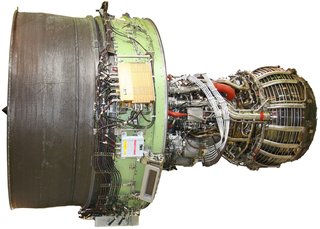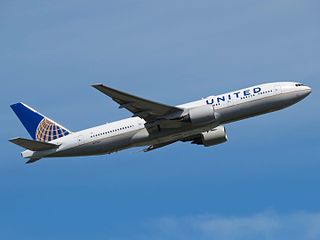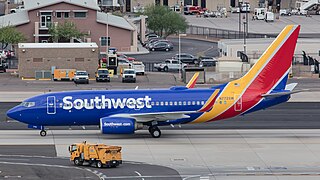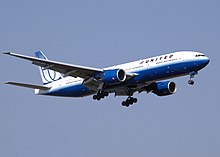
The Boeing 777, commonly referred to as the Triple Seven, is an American long-range wide-body airliner developed and manufactured by Boeing Commercial Airplanes. The 777 is the world's largest twinjet and the most-built wide-body airliner. The jetliner was designed to bridge the gap between Boeing's other wide body airplanes, the twin-engined 767 and quad-engined 747, and to replace aging DC-10 and L-1011 trijets. Developed in consultation with eight major airlines, the 777 program was launched in October 1990, with an order from United Airlines. The prototype was rolled out in April 1994, and first flew in June. The 777 entered service with the launch operator United Airlines in June 1995. Longer-range variants were launched in 2000, and first delivered in 2004.

The Pratt & Whitney PW4000 is a family of dual-spool, axial-flow, high-bypass turbofan aircraft engines produced by Pratt & Whitney as the successor to the JT9D. It was first run in April 1984, was FAA certified in July 1986, and was introduced in June 1987. With thrust ranging from 50,000 to 99,040 lbf, it is used on many wide-body aircraft.

The General Electric GE90 is a family of high-bypass turbofan aircraft engines built by GE Aerospace for the Boeing 777, with thrust ratings from 81,000 to 115,000 pounds-force. It entered service with British Airways in November 1995. It is one of three options for the 777-200, -200ER, and -300 versions, and the exclusive engine of the -200LR, -300ER, and 777F. It was the largest jet engine, until being surpassed in January 2020 by its successor, the 110,000 lbf (490 kN) GE9X, which has a 6-inch (15 cm) larger diameter fan. However, the GE90-115B, the most recent variant, is rated for a higher thrust than the GE9X.

The Pratt & Whitney PW2000, also known by the military designation F117 and initially referred to as the JT10D, is a series of high-bypass turbofan aircraft engines with a thrust range from 37,000 to 43,000 lbf. Built by Pratt & Whitney, they were designed for the Boeing 757. As a 757 powerplant, these engines compete with the Rolls-Royce RB211.

The General Electric GEnx is an advanced dual rotor, axial flow, high-bypass turbofan jet engine in production by GE Aerospace for the Boeing 747-8 and 787. The GEnx succeeded the CF6 in GE's product line.

The General Electric CF6, US military designations F103 and F138, is a family of high-bypass turbofan engines produced by GE Aviation. Based on the TF39, the first high-power high-bypass jet engine, the CF6 powers a wide variety of civilian airliners. The basic engine core also powers the LM2500 and LM6000 marine and power generation turboshafts. It is gradually being replaced by the newer GEnx family.

The Rolls-Royce Trent 800 is a high-bypass turbofan produced by Rolls-Royce plc, one of the engine options for the early Boeing 777 variants. Launched in September 1991, it first ran in September 1993, was granted EASA certification on 27 January 1995, and entered service in 1996. It reached a 40% market share, ahead of the competing PW4000 and GE90, and the last Trent 800-powered 777 was delivered in 2010. The Trent 800 has the Trent family three shaft architecture, with a 280 cm (110 in) fan. With a 6.4:1 bypass ratio and an overall pressure ratio reaching 40.7:1, it generates up to 413.4 kN of thrust.

A turbine engine failure occurs when a turbine engine unexpectedly stops producing power due to a malfunction other than fuel exhaustion. It often applies for aircraft, but other turbine engines can fail, like ground-based turbines used in power plants or combined diesel and gas vessels and vehicles.
Jin Air Co., Ltd. is a South Korean low-cost airline. As of April 2018 it operates flights to six domestic cities and 26 international destinations. It launched its first long haul route, between Incheon and Honolulu, in December 2015. It has operated cargo services since November 2013. Jin Air is the first widebody LCC operator in Korea.

Northwest Airlines Flight 5 was a flight from Miami International Airport to Minneapolis−Saint Paul International Airport, which, on January 4, 1990, suffered the loss of the number three (starboard) engine at 35,000 feet (11,000 m) in mid-flight over Madison, Florida.

British Airways Flight 2276 was a scheduled international passenger service from Las Vegas to London. On 8 September 2015, the Boeing 777-200ER operating the flight suffered an uncontained engine failure and fire in the left (#1) GE90 engine during take-off from Las Vegas-McCarran International Airport, prompting an aborted take-off and the evacuation of all passengers and crew. All 170 people on board survived, but 20 were injured.

On 27 May 2016, a Boeing 777-300 of Korean Air, operating as Korean Air Flight 2708 from Haneda Airport in Tokyo to Seoul's Gimpo International Airport, was accelerating for take off when its left engine suffered an uncontained failure and a substantial fire ensued. The crew aborted the take-off, and after the aircraft came to a stop the fire was extinguished by the airport emergency services. All 319 passengers and crew were evacuated; 12 occupants were injured. The accident was attributed to poor maintenance standards and failure of the crew to carry out the emergency procedures correctly.

Southwest Airlines Flight 3472 was a regularly scheduled passenger flight operating from New Orleans International Airport in New Orleans, Louisiana to Orlando International Airport in Orlando, Florida. On August 27, 2016, the Boeing 737-7H4, with 99 passengers and five crew, 12 minutes after departure from New Orleans, was climbing through 31,000 feet and heading east over the Gulf of Mexico when the aircraft's number one CFM International CFM56-7 engine suffered an engine failure. A fan blade in the engine broke due to a fatigue crack. The separated portion of the blade rotated within the engine, moving forward, striking the engine inlet. Debris from the damaged engine inlet punctured the left side of the fuselage causing a loss of cabin pressure and damaged the wing and empennage. Oxygen masks were deployed to passengers while the crew initiated an emergency descent to 10,000 feet. The aircraft then diverted to Pensacola International Airport for a safe landing about 20 minutes later without further incident. While the aircraft sustained substantial damage, there were no injuries.

On February 13, 2018, around noon local time, a Boeing 777-222 airplane, operating as United Airlines Flight 1175 (UA1175), experienced an in-flight separation of a fan blade in the No. 2 (right) engine while over the Pacific Ocean en route from San Francisco International Airport (SFO) to the Daniel K. Inouye International Airport (HNL), Honolulu, Hawaii. During level cruise flight shortly before beginning a descent from flight level 360, and about 120 miles from HNL, the flight crew heard a loud bang, followed by a violent shaking of the airplane, followed by warnings of a compressor stall. The flight crew shut down the failed engine, declared an emergency, and began a drift-down descent, proceeding direct to HNL where they made a single-engine landing without further incident at 12:37 local time. There were no reported injuries to the 374 passengers and crew on board and the airplane damage was classified as minor under National Transportation Safety Board (NTSB) criteria.

Southwest Airlines Flight 1380 was a Boeing 737-700 that experienced a contained engine failure in the left CFM International CFM56 engine after departing from New York–LaGuardia Airport en route to Dallas Love Field on April 17, 2018. The engine cowl was broken in the failure, and cowl fragments damaged the fuselage, shattering a cabin window and causing explosive depressurization of the aircraft. Other fragments caused damage to the wing. The crew carried out an emergency descent and diverted to Philadelphia International Airport. One passenger was partially ejected from the aircraft and sustained fatal injuries, while eight other passengers sustained minor injuries. The aircraft was substantially damaged.
Many aviation-related events took place in 2021. The aviation industry continued to be impacted by the COVID-19 pandemic.

Thermal acoustic imaging (TAI) is a proprietary active thermographic inspection process developed by Pratt and Whitney (P&W) in 2005; TAI is a nondestructive testing (NDT) method to detect internal and external cracking of hollow core turbofan engine fan blades. TAI is performed to inspect the PW4000 112-inch (2,800 mm) diameter fan blades in an enclosed air-conditioned room within P&W's overhaul and repair facility in East Hartford, Connecticut.

On February 20, 2021, Longtail Aviation Flight 5504, an international cargo flight operated by Longtail Aviation from Maastricht, Netherlands, to New York, United States, suffered an engine failure shortly after departure that caused debris to fall to the ground near the Dutch town of Meerssen. Two people on the ground were slightly injured and there was property damage to buildings and cars. The Boeing 747-400(BCF) cargo plane diverted to Liege Airport with the failed engine shut down and landed there safely.

Transair Flight 810 was a Boeing 737-200 converted freighter aircraft, owned and operated by Rhoades Aviation under the Transair trade name, on a short cargo flight en route from Honolulu International Airport to Kahului Airport on the neighboring Hawaiian island of Maui. Immediately after an early morning takeoff on July 2, 2021, one of its two Pratt & Whitney JT8D turbofan engines faltered, and the first officer, who was flying the aircraft, reduced power to both. The two pilots—who were the only aircraft occupants—began executing the Engine Failure or Shutdown checklist, but became preoccupied with talking to air traffic control (ATC) and performing other flying tasks, and never reached the section of the checklist where the failing engine was to be positively identified and shut down. The captain assumed control but misidentified the failing engine, increased power to that engine, and did not increase power to the other, properly functioning engine. Convinced that neither engine was working properly and unable to maintain altitude with one engine faltering and the other idling, the pilots ditched off the coast of Oahu about 11 minutes into the flight.

Broomfield County Commons Park, a 300-acre (1.2 km2) county park in Broomfield County, Colorado, in the United States, is home to the Paul Derda Recreation Center, County Commons cemetery, 237 acres (0.96 km2) of open space, and the 80-acre (0.32 km2) park and sports complex.
































